

Compact Muon Solenoid
LHC, CERN
| CMS-PAS-EXO-16-053 | ||
| Search for new physics in final states with a single photon plus missing transverse momentum in proton-proton collisions at √s= 13 TeV using 2016 data | ||
| CMS Collaboration | ||
| July 2018 | ||
| Abstract: A search is conducted for new physics in final states containing a photon and missing transverse momentum in proton-proton collisions at √s= 13 TeV, using the data collected by the CMS experiment at the CERN LHC in 2016 corresponding to an integrated luminosity of 35.9 fb−1. No deviations are observed relative to the predictions of the standard model. The results are interpreted in the context of dark matter production and models containing extra spatial dimensions. For the simplified dark matter production models considered, the observed (expected) exclusion for the mediator masses is 950 (1150) GeV for 1 GeV dark matter mass. For an effective dimension-7 photon-dark matter contact interaction, the observed (expected) values of the suppression parameter λ up to 850 (950) GeV are excluded. For the model with extra spatial dimensions, values of the effective Planck scale up to 2.85-2.90 TeV are excluded, depending on the number of extra dimensions. | ||
|
Links:
CDS record (PDF) ;
inSPIRE record ;
CADI line (restricted) ;
These preliminary results are superseded in this paper, JHEP 02 (2019) 074. The superseded preliminary plots can be found here. |
||
| Figures | |

png pdf |
Figure 1:
Leading-order diagrams of the simplified DM model (left), electroweak-DM effective interaction (center), and graviton (G) production in the ADD model (right), with a final state of γ and large pTmiss. |
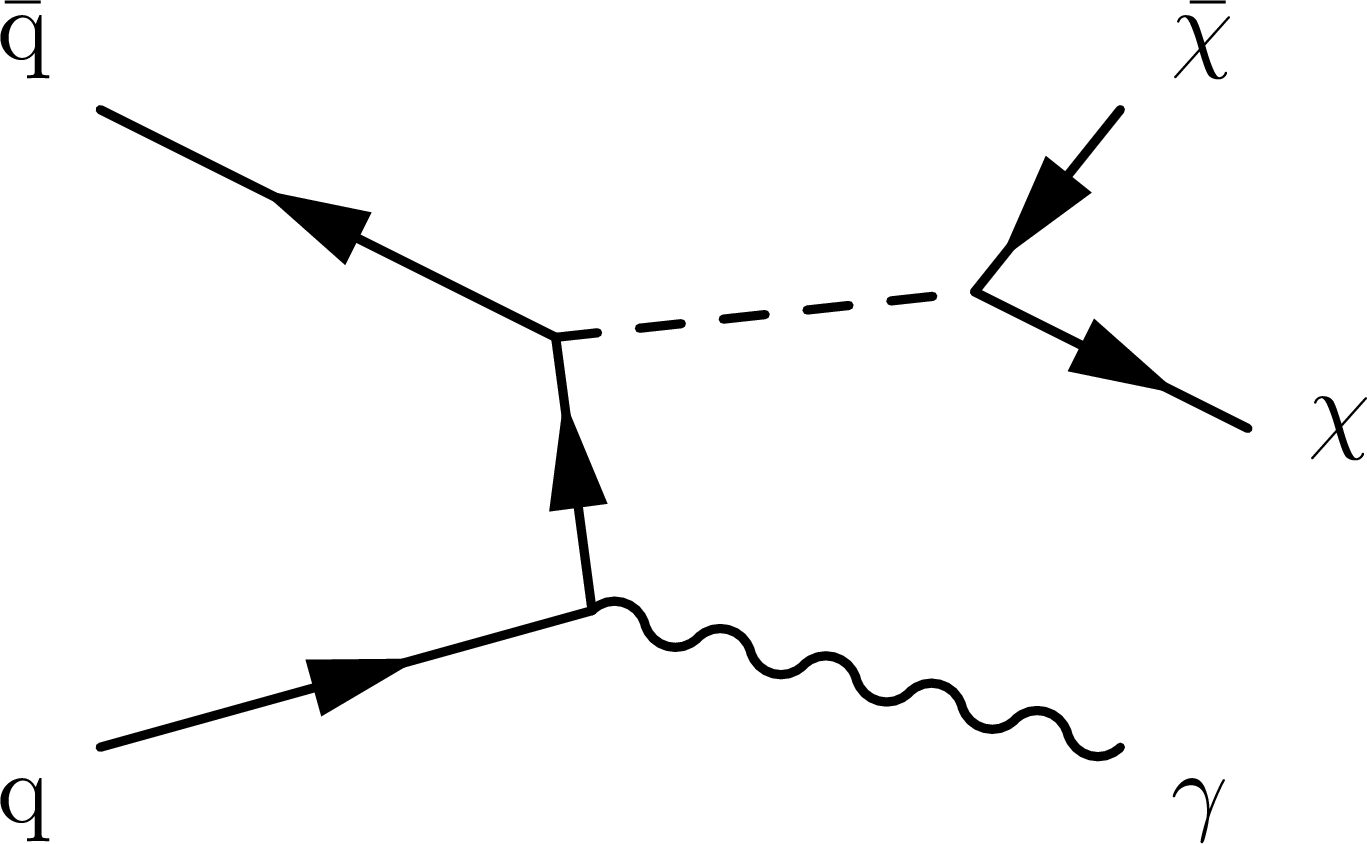
png pdf |
Figure 1-a:
Leading-order diagrams of the simplified DM model (left), electroweak-DM effective interaction (center), and graviton (G) production in the ADD model (right), with a final state of γ and large pTmiss. |
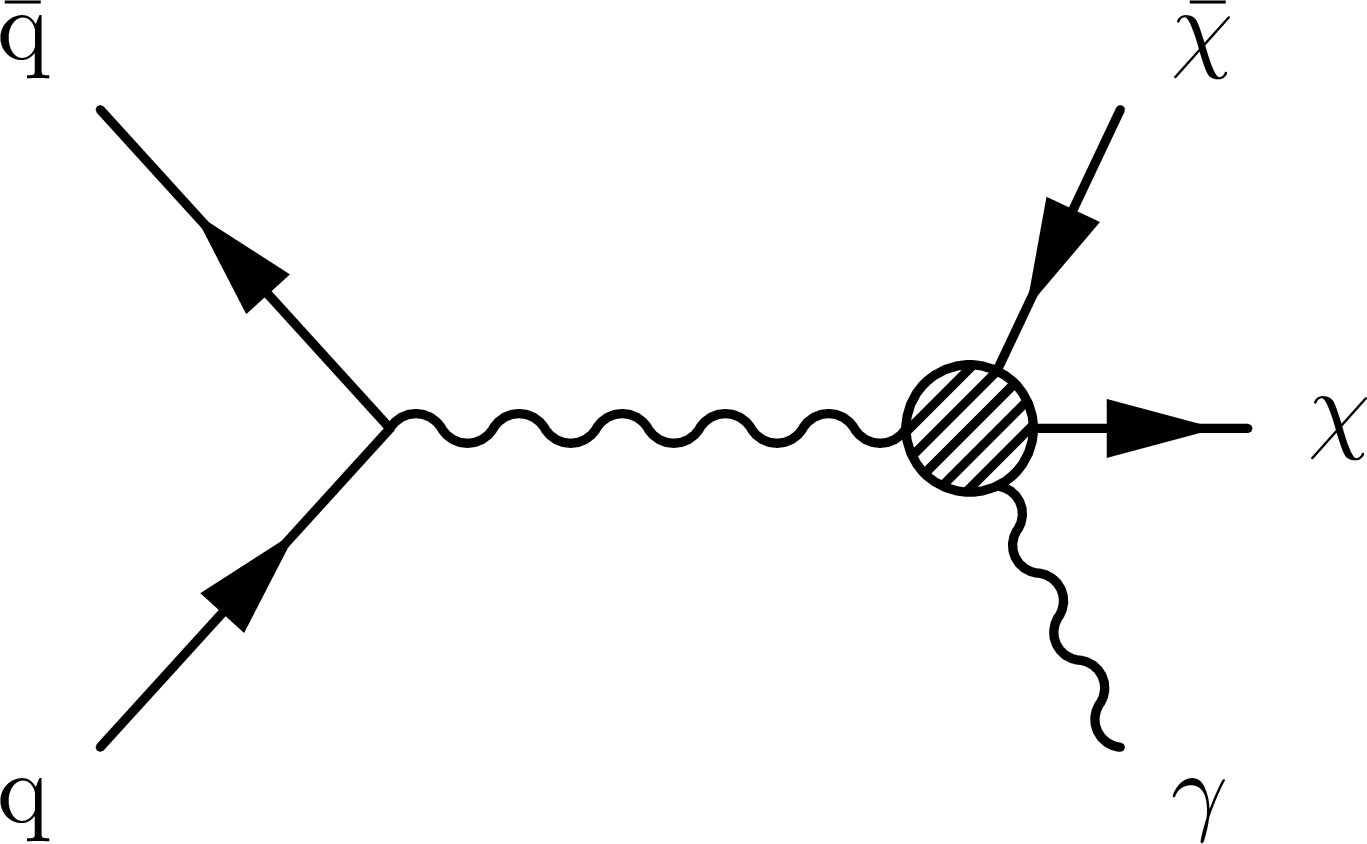
png pdf |
Figure 1-b:
Leading-order diagrams of the simplified DM model (left), electroweak-DM effective interaction (center), and graviton (G) production in the ADD model (right), with a final state of γ and large pTmiss. |
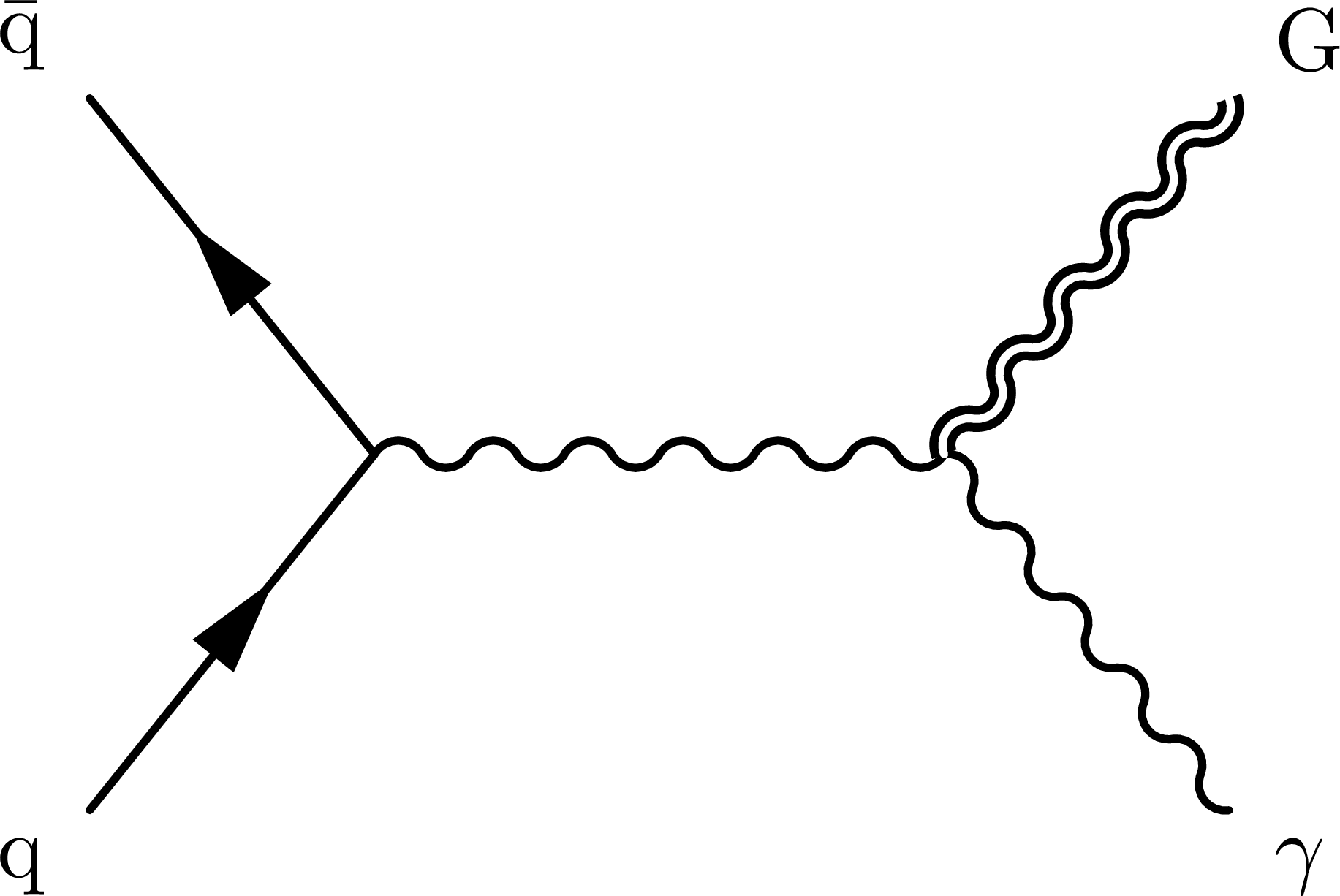
png pdf |
Figure 1-c:
Leading-order diagrams of the simplified DM model (left), electroweak-DM effective interaction (center), and graviton (G) production in the ADD model (right), with a final state of γ and large pTmiss. |
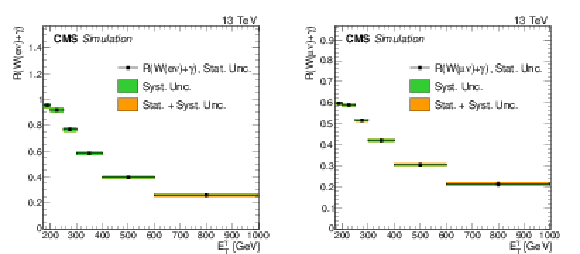
png pdf |
Figure 2:
Transfer factors RWγeγ (left) and RWγμγ (right).The uncertainty band in green and orange includes systematic only and systematic plus statistical uncertainties. |
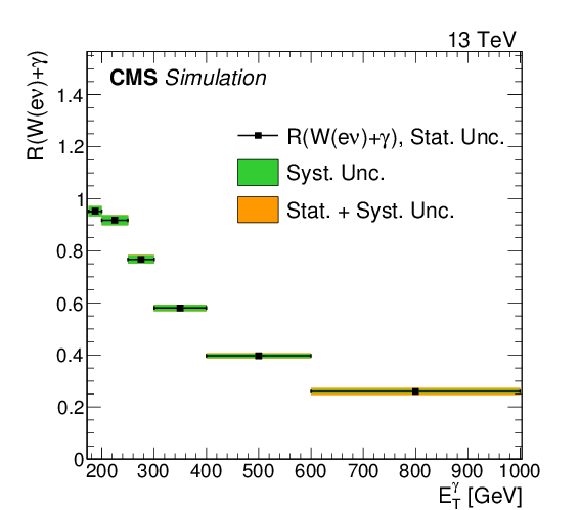
png pdf |
Figure 2-a:
Transfer factors RWγeγ (left) and RWγμγ (right).The uncertainty band in green and orange includes systematic only and systematic plus statistical uncertainties. |
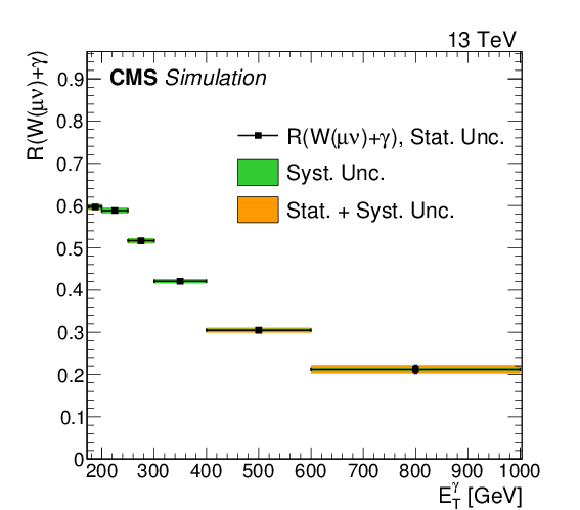
png pdf |
Figure 2-b:
Transfer factors RWγeγ (left) and RWγμγ (right).The uncertainty band in green and orange includes systematic only and systematic plus statistical uncertainties. |
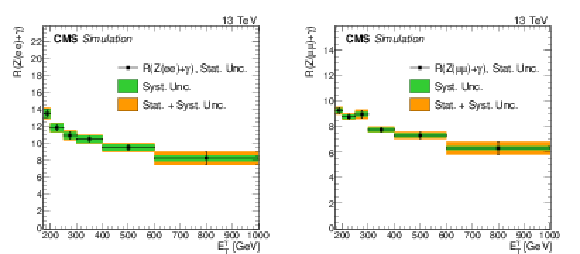
png pdf |
Figure 3:
Transfer factors RZγeeγ (left) and RZγμμγ (right). The uncertainty band in green and orange includes systematic only and systematic plus statistical uncertainties. |
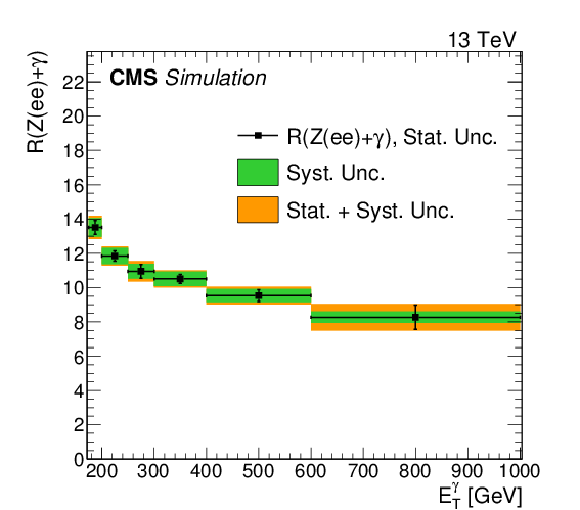
png pdf |
Figure 3-a:
Transfer factors RZγeeγ (left) and RZγμμγ (right). The uncertainty band in green and orange includes systematic only and systematic plus statistical uncertainties. |
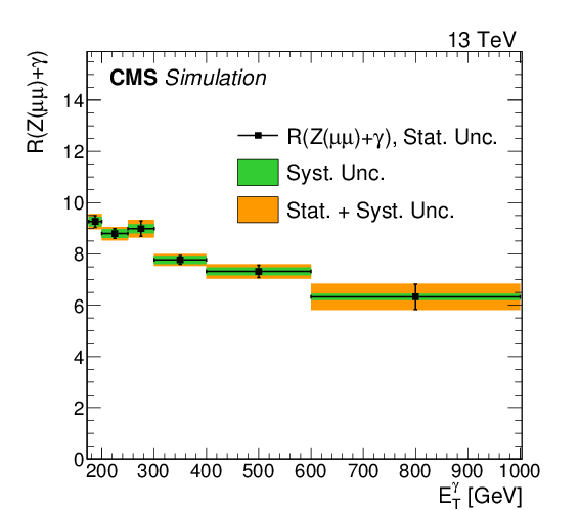
png pdf |
Figure 3-b:
Transfer factors RZγeeγ (left) and RZγμμγ (right). The uncertainty band in green and orange includes systematic only and systematic plus statistical uncertainties. |
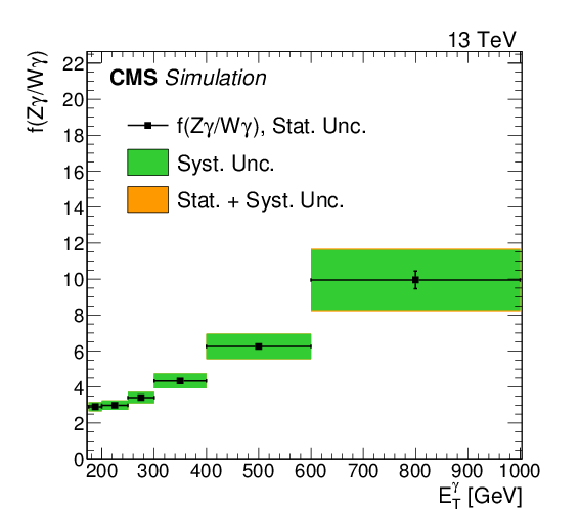
png pdf |
Figure 4:
Transfer factor fWγZγ. The uncertainty band in green and orange includes systematic only and systematic plus statistical uncertainties. |

png pdf |
Figure 5:
Comparison between data and MC simulation in the four control regions with eeγ (top left), μμγ (top right), eγ (bottom left), μγ (bottom right) before and after performing the simultaneous fit across all the control samples and signal region, and assuming absence of any signal. The last bin of the distribution includes all events with EγT> 1000 GeV. In the lower panel, the ratios of data with the pre-fit background prediction (red) and post-fit background prediction (blue) are shown. The band in the lower panel shows the post-fit uncertainty after combining all the systematic uncertainties. |
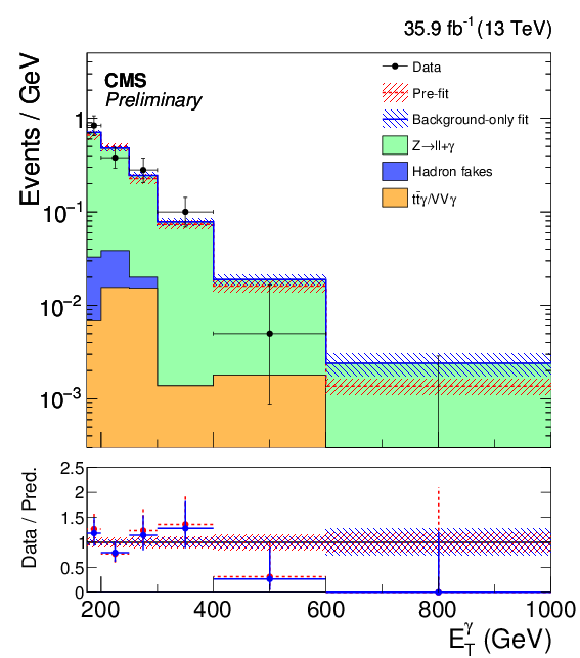
png pdf |
Figure 5-a:
Comparison between data and MC simulation in the four control regions with eeγ (top left), μμγ (top right), eγ (bottom left), μγ (bottom right) before and after performing the simultaneous fit across all the control samples and signal region, and assuming absence of any signal. The last bin of the distribution includes all events with EγT> 1000 GeV. In the lower panel, the ratios of data with the pre-fit background prediction (red) and post-fit background prediction (blue) are shown. The band in the lower panel shows the post-fit uncertainty after combining all the systematic uncertainties. |

png pdf |
Figure 5-b:
Comparison between data and MC simulation in the four control regions with eeγ (top left), μμγ (top right), eγ (bottom left), μγ (bottom right) before and after performing the simultaneous fit across all the control samples and signal region, and assuming absence of any signal. The last bin of the distribution includes all events with EγT> 1000 GeV. In the lower panel, the ratios of data with the pre-fit background prediction (red) and post-fit background prediction (blue) are shown. The band in the lower panel shows the post-fit uncertainty after combining all the systematic uncertainties. |
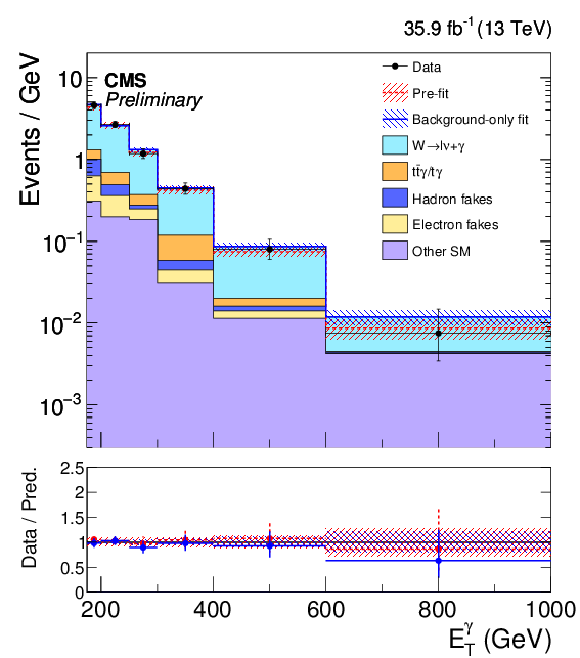
png pdf |
Figure 5-c:
Comparison between data and MC simulation in the four control regions with eeγ (top left), μμγ (top right), eγ (bottom left), μγ (bottom right) before and after performing the simultaneous fit across all the control samples and signal region, and assuming absence of any signal. The last bin of the distribution includes all events with EγT> 1000 GeV. In the lower panel, the ratios of data with the pre-fit background prediction (red) and post-fit background prediction (blue) are shown. The band in the lower panel shows the post-fit uncertainty after combining all the systematic uncertainties. |
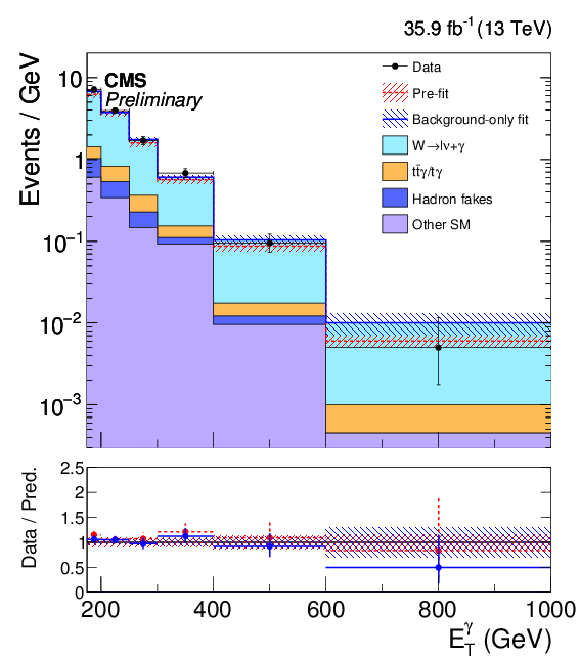
png pdf |
Figure 5-d:
Comparison between data and MC simulation in the four control regions with eeγ (top left), μμγ (top right), eγ (bottom left), μγ (bottom right) before and after performing the simultaneous fit across all the control samples and signal region, and assuming absence of any signal. The last bin of the distribution includes all events with EγT> 1000 GeV. In the lower panel, the ratios of data with the pre-fit background prediction (red) and post-fit background prediction (blue) are shown. The band in the lower panel shows the post-fit uncertainty after combining all the systematic uncertainties. |
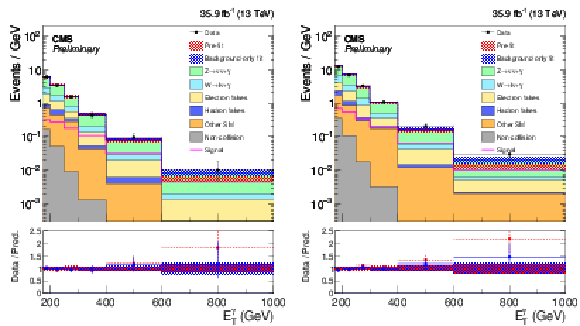
png pdf |
Figure 6:
Observed EγT distributions in the horizontal (left) and vertical (right) signal regions compared with the post-fit background expectations for various SM processes. The last bin of the distribution includes all events with EγT> 1000 GeV. The expected background distributions are evaluated after performing a combined fit to the data in all the control samples, not including the signal region. In the lower panel, the ratios of data with the pre-fit background prediction (red) and post-fit background predition (blue) are shown. The band in the lower-panel shows the post-fit uncertainty after combining all the systematic uncertainties. The expected signal distribution from a 1 TeV vector mediator decaying to 1 GeV DM particles is overlaid. |
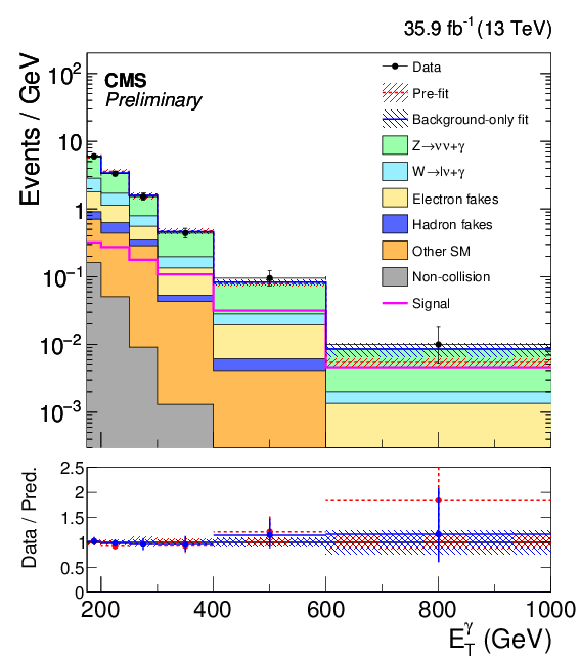
png pdf |
Figure 6-a:
Observed EγT distributions in the horizontal (left) and vertical (right) signal regions compared with the post-fit background expectations for various SM processes. The last bin of the distribution includes all events with EγT> 1000 GeV. The expected background distributions are evaluated after performing a combined fit to the data in all the control samples, not including the signal region. In the lower panel, the ratios of data with the pre-fit background prediction (red) and post-fit background predition (blue) are shown. The band in the lower-panel shows the post-fit uncertainty after combining all the systematic uncertainties. The expected signal distribution from a 1 TeV vector mediator decaying to 1 GeV DM particles is overlaid. |
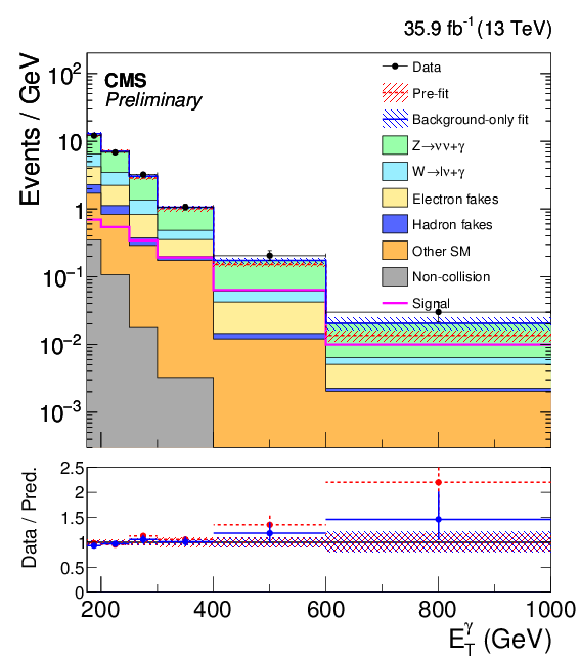
png pdf |
Figure 6-b:
Observed EγT distributions in the horizontal (left) and vertical (right) signal regions compared with the post-fit background expectations for various SM processes. The last bin of the distribution includes all events with EγT> 1000 GeV. The expected background distributions are evaluated after performing a combined fit to the data in all the control samples, not including the signal region. In the lower panel, the ratios of data with the pre-fit background prediction (red) and post-fit background predition (blue) are shown. The band in the lower-panel shows the post-fit uncertainty after combining all the systematic uncertainties. The expected signal distribution from a 1 TeV vector mediator decaying to 1 GeV DM particles is overlaid. |
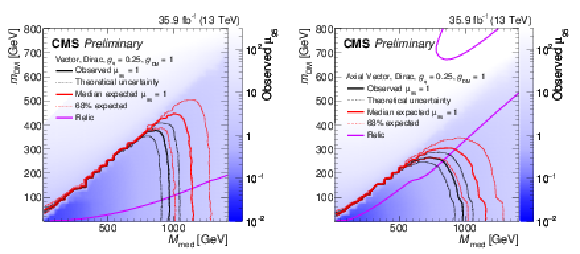
png pdf |
Figure 7:
The ratio of 95% CL cross section upper limits to theoretical cross section (μ95), for DM simplified models with vector (left) and axial-vector (right) mediators, assuming gq= 0.25 and gDM= 1. Expected μ95= 1 contours are overlaid. The region below the observed contour is excluded. |

png pdf |
Figure 7-a:
The ratio of 95% CL cross section upper limits to theoretical cross section (μ95), for DM simplified models with vector (left) and axial-vector (right) mediators, assuming gq= 0.25 and gDM= 1. Expected μ95= 1 contours are overlaid. The region below the observed contour is excluded. |
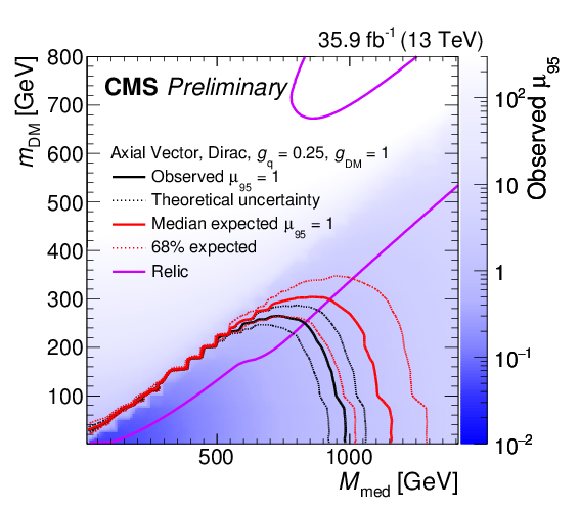
png pdf |
Figure 7-b:
The ratio of 95% CL cross section upper limits to theoretical cross section (μ95), for DM simplified models with vector (left) and axial-vector (right) mediators, assuming gq= 0.25 and gDM= 1. Expected μ95= 1 contours are overlaid. The region below the observed contour is excluded. |
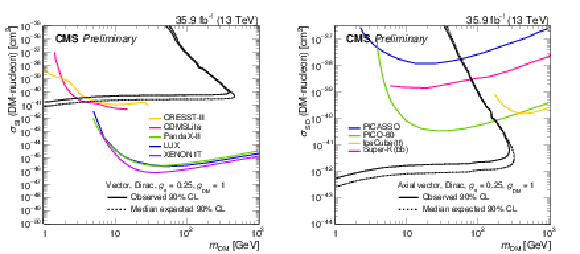
png pdf |
Figure 8:
The 90% CL exclusion limits on the χ-nucleon spin-independent (left) and spin-dependent (right) scattering cross sections involving vector and axial-vector operators, respectively, as a function of the mDM. Simplified model DM parameters of gq= 0.25 and gDM= 1 are assumed. The region to the upper left of the contour is excluded. On the plots, the median expected 90% CL curve overlaps the observed 90% CL curve. Also shown are corresponding exclusion contours, where regions above the curves are excluded, from the recent results by CDMSLite [36], LUX [37], PandaX [38], CRESST-II [39], PICO-60 [40], IceCube [41], PICASSO [42] and Super-Kamiokande [43] Collaborations. |
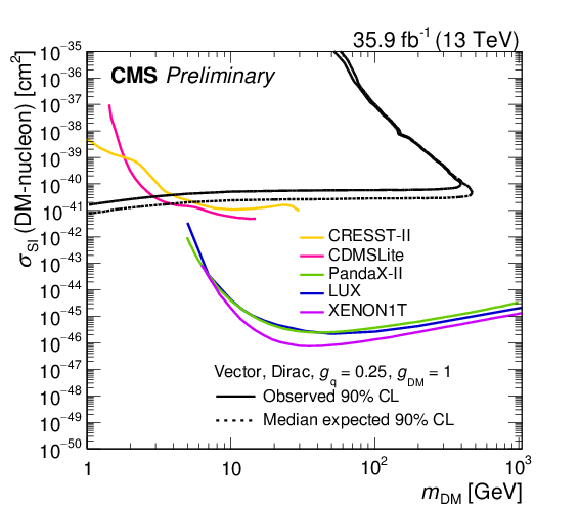
png pdf |
Figure 8-a:
The 90% CL exclusion limits on the χ-nucleon spin-independent (left) and spin-dependent (right) scattering cross sections involving vector and axial-vector operators, respectively, as a function of the mDM. Simplified model DM parameters of gq= 0.25 and gDM= 1 are assumed. The region to the upper left of the contour is excluded. On the plots, the median expected 90% CL curve overlaps the observed 90% CL curve. Also shown are corresponding exclusion contours, where regions above the curves are excluded, from the recent results by CDMSLite [36], LUX [37], PandaX [38], CRESST-II [39], PICO-60 [40], IceCube [41], PICASSO [42] and Super-Kamiokande [43] Collaborations. |
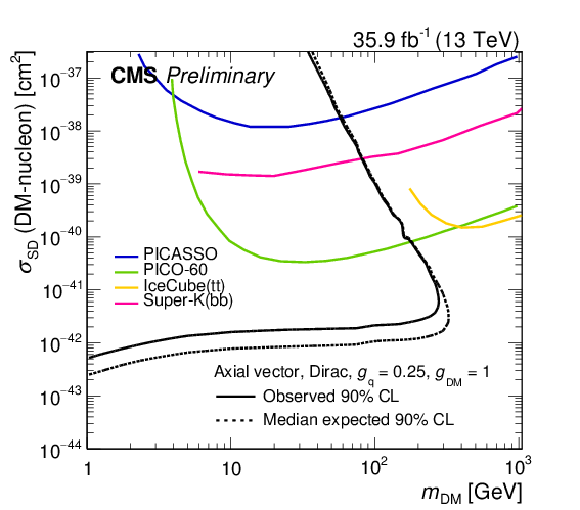
png pdf |
Figure 8-b:
The 90% CL exclusion limits on the χ-nucleon spin-independent (left) and spin-dependent (right) scattering cross sections involving vector and axial-vector operators, respectively, as a function of the mDM. Simplified model DM parameters of gq= 0.25 and gDM= 1 are assumed. The region to the upper left of the contour is excluded. On the plots, the median expected 90% CL curve overlaps the observed 90% CL curve. Also shown are corresponding exclusion contours, where regions above the curves are excluded, from the recent results by CDMSLite [36], LUX [37], PandaX [38], CRESST-II [39], PICO-60 [40], IceCube [41], PICASSO [42] and Super-Kamiokande [43] Collaborations. |
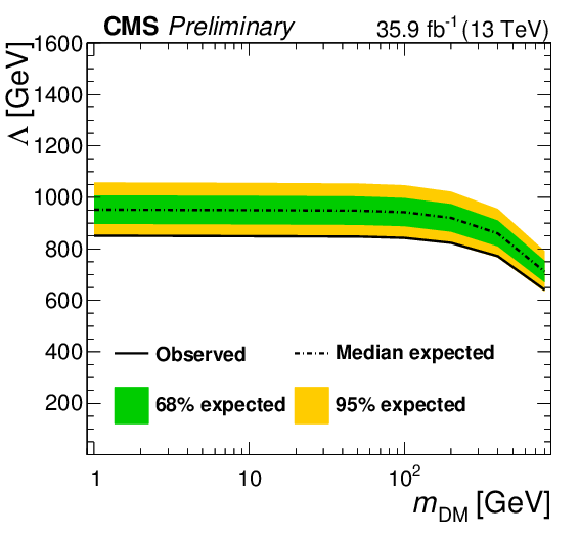
png pdf |
Figure 9:
(a) The 95% CL observed and expected lower limits on λ for a dimension-7 operator EFT model with a contact interaction of type γγχ¯χ as a function of dark matter mass mχ. |

png pdf |
Figure 10:
The 95% CL upper limits on the ADD graviton production cross section, as a function of MD for n= 3 extra dimensions. |
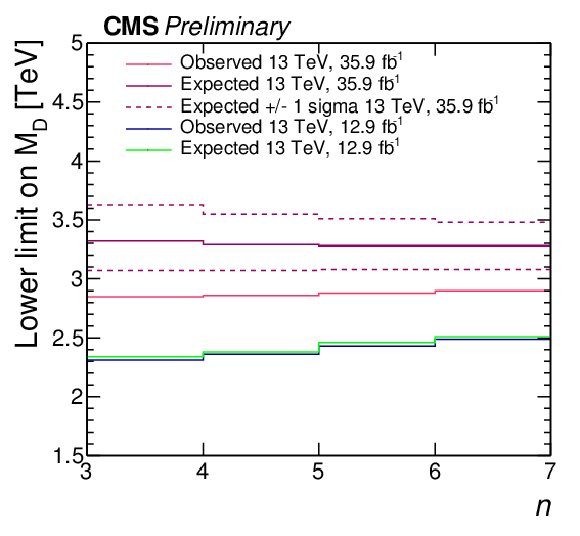
png pdf |
Figure 11:
Lower limit on MD as a function of n, the number of ADD extra dimensions. |
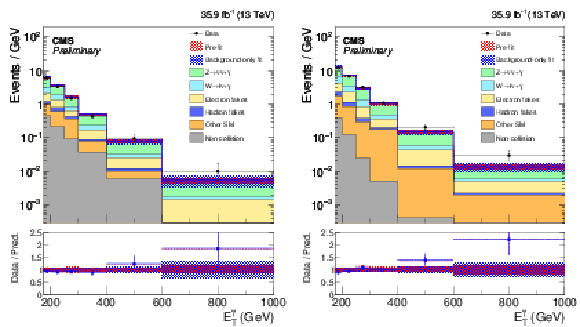
png pdf |
Figure 12:
Observed EγT distribution in the horizontal (a) and vertical (b) signal regions compared with the post-fit background expectations for various SM processes. The last bin includes all events with EγT> 1000 GeV. The expected background distributions are evaluated after performing a combined fit to the data in all the control samples, not including the signal region. |
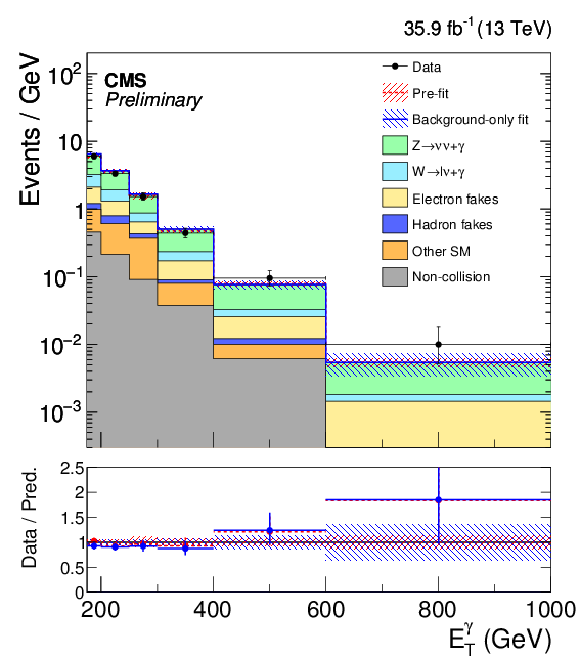
png pdf |
Figure 12-a:
Observed EγT distribution in the horizontal (a) and vertical (b) signal regions compared with the post-fit background expectations for various SM processes. The last bin includes all events with EγT> 1000 GeV. The expected background distributions are evaluated after performing a combined fit to the data in all the control samples, not including the signal region. |
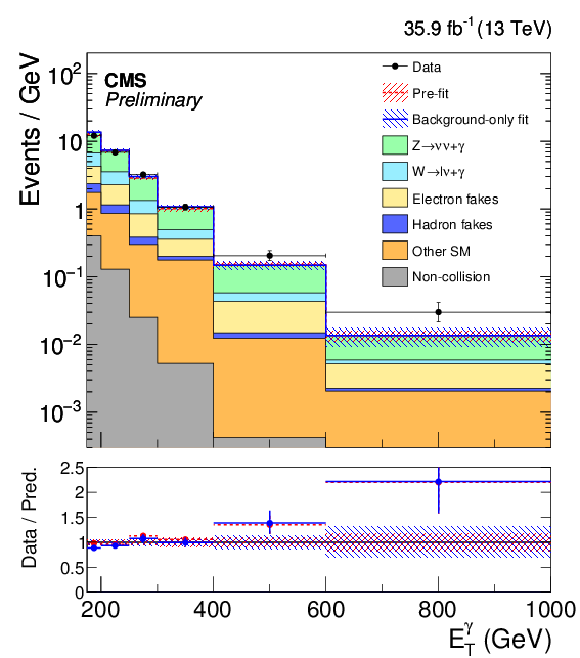
png pdf |
Figure 12-b:
Observed EγT distribution in the horizontal (a) and vertical (b) signal regions compared with the post-fit background expectations for various SM processes. The last bin includes all events with EγT> 1000 GeV. The expected background distributions are evaluated after performing a combined fit to the data in all the control samples, not including the signal region. |
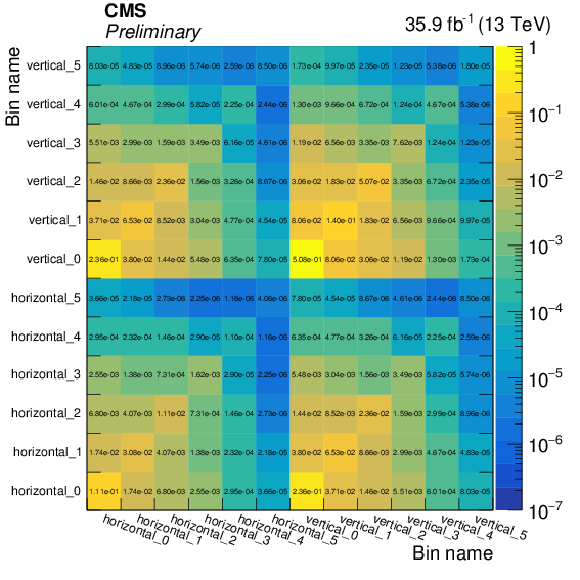
png pdf |
Figure 13:
Covariances between the predicted background yields in all the EγT bins of the horizontal and vertical signal regions. The bin labels specify which signal region the bin belongs to and what number bin it is for that region. |
| Tables | |
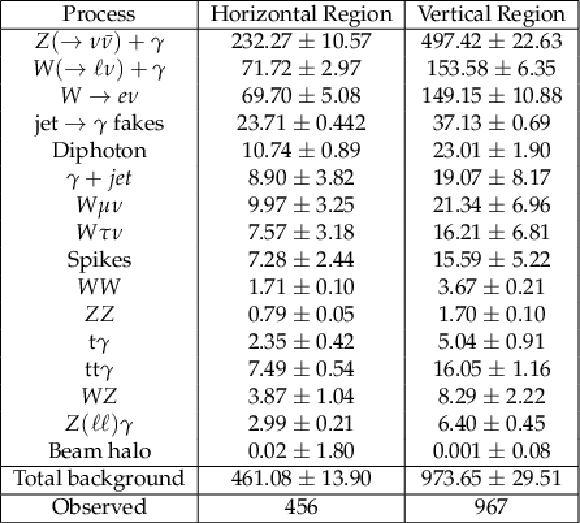
png pdf |
Table 1:
Expected event yield for various background processes in the horizontal and vertical, signal region, respectively. The background yields and the corresponding uncertainties are obtained after performing a combined fit to data in all the control samples, excluding data in the signal region. The observed event yield in the signal region is also reported. |

png pdf |
Table 2:
The 95% CL observed and expected lower limits on MD as a function of n, the number of ADD extra dimensions. |

png pdf |
Table 3:
Expected event yields in each EγT bin for various background processes in the horiontal signal region. The background yields and the corresponding uncertainties are obtained after performing a combined fit to data in all the control samples, excluding data in the signal region. The observed event yields in the horizontal signal region are also reported. |

png pdf |
Table 4:
Expected event yields in each EγT bin for various background processes in the horiontal signal region. The background yields and the corresponding uncertainties are obtained after performing a combined fit to data in all the control samples, excluding data in the signal region. The observed event yields in the vertical signal region are also reported. |

png pdf |
Table 5:
Cut-by-cut efficiencies for irreducible Zγ and Wγ processes as well as two representative signal models: a 1 TeV vector mediator decaying to 1 GeV DM particles and an ADD graviton model with 8 extra dimensions and a fundamental Planck scale (MD) of 3 TeV |
| Summary |
| Proton-proton collisions producing large missing transverse momentum and a high transverse momentum photon have been investigated to search for new phenomena, using a data set corresponding to 35.9 fb−1 of integrated luminosity recorded at √s= 13 TeV at the CERN LHC. No deviations from the standard model predictions are observed. Using the new analysis technique of extracting the signal from the data via simultaneous fits to the ETγ distributions in the signal region and control regions resulted in 37% and 43% gain in expected limits for both the DM and ADD signal model compared to previously published analysis [9]. For the simplified dark matter production models considered, the observed (expected) exclusion for the mediator masses is 950 (1150) GeV for 1 GeV dark matter mass. For an effective dimension-7 photon-dark matter contact interaction, the observed (expected) values of the suppression parameter λ up to 850 (950) GeV are excluded. For the model with extra spatial dimensions, values of the effective Planck scale up to 2.85-2.90 TeV, are excluded for 3-6 extra dimensions, respecively. |
| References | ||||
| 1 | P. J. Fox, R. Harnik, J. Kopp, and Y. Tsai | Missing energy signatures of dark matter at the LHC | PRD 85 (2012) 056011 | 1109.4398 |
| 2 | J. Goodman et al. | Constraints on dark matter from colliders | PRD 82 (2010) 116010 | 1008.1783 |
| 3 | G. Busoni et al. | Recommendations on presenting LHC searches for missing transverse energy signals using simplified s-channel models of dark matter | 1603.04156 | |
| 4 | D. Abercrombie et al. | Dark matter benchmark models for early LHC Run-2 searches: Report of the ATLAS/CMS Dark Matter Forum | 1507.00966 | |
| 5 | A. Nelson et al. | Confronting the Fermi line with LHC data: An effective theory of dark matter interaction with photons | PRD 89 (2014) 056011 | 1307.5064 |
| 6 | N. Arkani-Hamed, S. Dimopoulos, and G. Dvali | The hierarchy problem and new dimensions at a millimeter | PLB 429 (1998) 263 | hep-ph/9803315 |
| 7 | N. Arkani-Hamed, S. Dimopoulos, and G. Dvali | Phenomenology, astrophysics, and cosmology of theories with submillimeter dimensions and tev scale quantum gravity | PRD 59 (1999) 086004 | |
| 8 | ATLAS Collaboration | Search for dark matter at √s= 13 TeV in final states containing an energetic photon and large missing transverse momentum with the ATLAS detector | EPJC 77 (2017), no. 6, 393 | 1704.03848 |
| 9 | CMS Collaboration | Search for new physics in the monophoton final state in proton-proton collisions at √s= 13 TeV | JHEP 10 (2017) 073 | CMS-EXO-16-039 1706.03794 |
| 10 | CMS Collaboration | The CMS experiment at the CERN LHC | JINST 3 (2008) S08004 | CMS-00-001 |
| 11 | CMS Collaboration | The CMS trigger system | JINST 12 (2017), no. 01, P01020 | CMS-TRG-12-001 1609.02366 |
| 12 | CMS Collaboration | Description and performance of track and primary-vertex reconstruction with the CMS tracker | JINST 9 (2014), no. 10, P10009 | CMS-TRK-11-001 1405.6569 |
| 13 | M. Cacciari, G. P. Salam, and G. Soyez | The anti-kt jet clustering algorithm | JHEP 04 (2008) 063 | 0802.1189 |
| 14 | M. Cacciari, G. P. Salam, and G. Soyez | FastJet User Manual | EPJC72 (2012) 1896 | 1111.6097 |
| 15 | CMS Collaboration | Particle-flow reconstruction and global event description with the CMS detector | JINST 12 (2017), no. 10, P10003 | CMS-PRF-14-001 1706.04965 |
| 16 | CMS Collaboration | Performance of the CMS missing transverse momentum reconstruction in pp data at √s= 8 TeV | JINST 10 (2015) P02006 | CMS-JME-13-003 1411.0511 |
| 17 | W. Adam, R. Fruhwirth, A. Strandlie, and T. Todorov | Reconstruction of electrons with the gaussian-sum filter in the cms tracker at the lhc | JPG 31 (2005) N9 | |
| 18 | CMS Collaboration | Performance of electron reconstruction and selection with the CMS detector in proton-proton collisions at √s= 8 TeV | JINST 10 (2015) P06005 | CMS-EGM-13-001 1502.02701 |
| 19 | CMS Collaboration | Performance of photon reconstruction and identification with the CMS detector in proton-proton collisions at √s= 8 TeV | JINST 10 (2015) P08010 | CMS-EGM-14-001 1502.02702 |
| 20 | CMS Collaboration Collaboration | Timing performance of the CMS ECAL and prospects for the future. Timing performance of the CMS electromagnetic calorimeter and prospects for the future | CMS-CR-2014-074 | |
| 21 | J. Alwall et al. | The automated computation of tree-level and next-to-leading order differential cross sections, and their matching to parton shower simulations | JHEP 07 (2014) 079 | 1405.0301 |
| 22 | T. Sjostrand et al. | An introduction to PYTHIA 8.2 | CPC 191 (2015) 159 | 1410.3012 |
| 23 | NNPDF Collaboration | Parton distributions for the LHC Run II | JHEP 04 (2015) 040 | 1410.8849 |
| 24 | CMS Collaboration | Event generator tunes obtained from underlying event and multiparton scattering measurements | EPJC 76 (2016) 155 | CMS-GEN-14-001 1512.00815 |
| 25 | GEANT4 Collaboration | Geant4---a simulation toolkit | NIMA 506 (2003) 250 | |
| 26 | J. Allison et al. | Geant4 developments and applications | IEEE Trans. Nucl. Sci 53 (2006) 270 | |
| 27 | S. Catani, D. de Florian, G. Ferrera, and M. Grazzini | Vector boson production at hadron colliders: transverse-momentum resummation and leptonic decay | JHEP 12 (2015) 047 | 1507.06937 |
| 28 | A. Denner, S. Dittmaier, M. Hecht, and C. Pasold | NLO QCD and electroweak corrections to W+γ production with leptonic W-boson decays | JHEP 04 (2015) 018 | 1412.7421 |
| 29 | A. Denner, S. Dittmaier, M. Hecht, and C. Pasold | NLO QCD and electroweak corrections to Z+γ production with leptonic Z-boson decays | JHEP 02 (2016) 057 | 1510.08742 |
| 30 | A. V. Manohar, P. Nason, G. P. Salam, and G. Zanderighi | The Photon Content of the Proton | JHEP 12 (2017) 046 | 1708.01256 |
| 31 | J. M. Lindert et al. | Precise predictions for V+ jets dark matter backgrounds | EPJC77 (2017), no. 12, 829 | 1705.04664 |
| 32 | T. Junk | Confidence level computation for combining searches with small statistics | NIMA 434 (1999) 435 | hep-ex/9902006 |
| 33 | A. L. Read | Presentation of search results: The CLs technique | JPG 28 (2002) 2693 | |
| 34 | The ATLAS and CMS Collaborations and the LHC Higgs Combination Group | Procedure for the LHC Higgs boson search combination in Summer 2011 | ||
| 35 | G. Cowan, K. Cranmer, E. Gross, and O. Vitells | Asymptotic formulae for likelihood-based tests of new physics | EPJC 71 (2011) 1554 | 1007.1727 |
| 36 | SuperCDMS Collaboration | New Results from the Search for Low-Mass Weakly Interacting Massive Particles with the CDMS Low Ionization Threshold Experiment | PRL 116 (2016) 071301 | 1509.02448 |
| 37 | LUX Collaboration | Results from a search for dark matter in the complete LUX exposure | PRL 118 (2017) 021303 | 1608.07648 |
| 38 | PandaX-II Collaboration | Dark Matter Results from First 98.7 Days of Data from the PandaX-II Experiment | PRL 117 (2016) 121303 | 1607.07400 |
| 39 | CRESST Collaboration | Results on light dark matter particles with a low-threshold CRESST-II detector | EPJC 76 (2016) 25 | 1509.01515 |
| 40 | PICO Collaboration | Dark Matter Search Results from the PICO-60 C3F8 Bubble Chamber | 1702.07666 | |
| 41 | IceCube Collaboration | Improved limits on dark matter annihilation in the Sun with the 79-string IceCube detector and implications for supersymmetry | JCAP 04 (2016) 022 | 1601.00653 |
| 42 | E. Behnke et al. | Final results of the PICASSO dark matter search experiment | Astropart. Phys. 90 (2017) 85 | 1611.01499 |
| 43 | Super-Kamiokande Collaboration | Search for Neutrinos from Annihilation of Captured Low-Mass Dark Matter Particles in the Sun By Super-Kamiokande | PRL 114 (2015) 141301 | 1503.04858 |
| 44 | G. F. Giudice, R. Rattazzi, and J. D. Wells | Quantum gravity and extra dimensions at high-energy colliders | NPB 544 (1999) 3 | hep-ph/9811291 |
| 45 | CMS Collaboration | Simplified likelihood for the re-interpretation of public CMS results | CDS | |

|
Compact Muon Solenoid LHC, CERN |

|

|

|

|

|

|